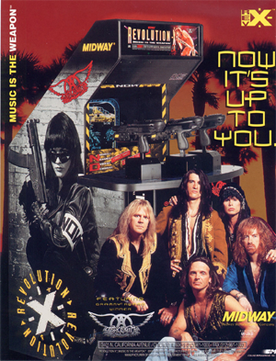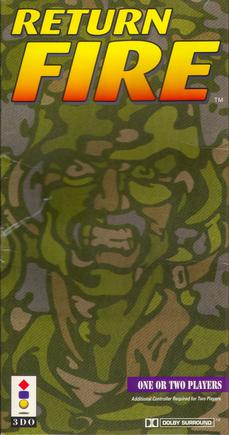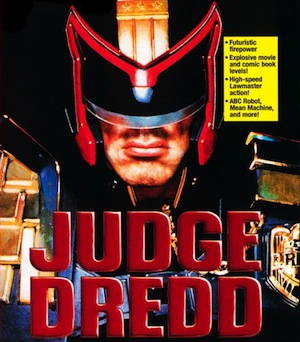
Zoop is a puzzle video game originally developed by Hookstone and published by Viacom New Media in 1995 for the Genesis, Super Nintendo Entertainment System, MS-DOS, Macintosh, PlayStation, Game Gear, and Game Boy, then in 1996 for the Saturn and Jaguar. Zoop has similarities to Taito's 1989 arcade video game Plotting, but Zoop runs in real-time instead. Players are tasked with eliminating pieces that spawn from one of the sides of the screen before they reach the center of the playfield. By pointing at a piece and shooting it, the player can either swap it with the current player color and thus arrange the same color pieces in a row or column, or match the color.

The 3DO Interactive Multiplayer, also referred to as simply 3DO, is a home video game console developed by The 3DO Company. Conceived by entrepreneur and Electronic Arts founder Trip Hawkins, the 3DO was not a console manufactured by the company itself, but a set of specifications, originally designed by Dave Needle and RJ Mical of New Technologies Group, that could be licensed by third parties. Panasonic produced the first models in 1993, and further renditions of the hardware were released afterwards by GoldStar, Sanyo, Creative Labs, and Samsung Electronics in 1997.

Earthworm Jim is a 1994 run and gun platform game developed by Shiny Entertainment, featuring an earthworm named Jim, who wears a robotic suit and battles the forces of evil. The game was released for the Sega Genesis and Super Nintendo Entertainment System, before being subsequently ported to a number of other video game consoles.

Revolution X is a shooting gallery video game developed by Midway and released in arcades in 1994. The gameplay is similar to Midway's earlier Terminator 2: Judgment Day, but is themed around the band Aerosmith. The oppressive New Order Nation regime and their leader Helga have abducted Aerosmith, and players use a mounted gun to control onscreen crosshairs and shoot enemies. The members of Aerosmith are hidden throughout the game's international locales and must be found in order to receive the game's true ending.

Primal Rage is a fighting game developed and released by Atari Games for arcades in 1994. The game takes place on a post-apocalyptic version of Earth called "Urth". Players control one of seven prehistoric beasts, that battle each other to determine the planet's fate. Matches feature many of the conventions of fighting games from the era, including special moves and gory finishing maneuvers. Ports were released for home consoles and personal computers. Efforts to perfectly emulate the arcade original have been unsuccessful due to the use of an unusual copy protection method. Toys, comics, a novel and other merchandise tie-ins were produced. More than 1.5 million copies of the game were sold.

Syndicate is an isometric real-time tactical and strategic game from Bullfrog Productions created in 1993, and released for a variety of platforms beginning with the PC and Commodore Amiga. It is the first title in the Syndicate series. Set in a dystopian future in which corporations have replaced governments, Syndicate puts the player in control of a corporation vying for global dominance.

Magic Carpet is a 3D flying video game developed by Bullfrog Productions and published by Electronic Arts in 1994. Its graphics and gameplay were considered innovative and technically impressive at the time of its release.

Corpse Killer is a horror-themed rail shooter developed and published by Digital Pictures for the Sega CD, Sega CD 32X, 3DO, Sega Saturn, Windows 95 and Macintosh computers. An interactive variation on the zombie film genre, it utilizes live-action full motion video in a format similar to other games developed by Digital Pictures. Reviews for the game were mixed, generally criticizing the repetitive gameplay and low video quality, though many reviewers enjoyed the campy nature of the cutscenes. Corpse Killer was the first CD game released for the Sega 32X. It was later remastered for Steam, PlayStation 4 and Nintendo Switch.

FIFA International Soccer is a 1993 association football video game developed by EA Canada's Extended Play Productions team and published by Electronic Arts. The game was released for the Sega Mega Drive/Genesis console in December 1993 and ported to numerous other systems in 1994. It is the first game in the FIFA series.

Batman Forever: The Arcade Game is a beat 'em up video game based on the movie Batman Forever. The subtitle is used to differentiate it from Batman Forever, another beat 'em up published by Acclaim at around the same time. One or two players, playing as Batman and Robin, fight Two-Face, the Riddler, and numerous henchmen.

Pitfall: The Mayan Adventure is a side-scrolling action-platform video game developed by Activision in conjunction with Kroyer Films and originally published in North America and Europe in 1994. The fourth installment in the Pitfall! franchise, players assume the role of Pitfall Harry Junior as he embarks on a journey through the Mayan jungles of Central America in an attempt to rescue Pitfall Harry, his father and the protagonist of previous entries in the series, from the evil Mayan warrior spirit named Zakelua. Its gameplay mainly consists of action and platforming mixed with stage-based exploration using a main six-button configuration.

Return Fire is a 1995 video game developed by Silent Software, Inc. for the 3DO Interactive Multiplayer and ported to the PC and PlayStation in 1996. It was preceded by Fire Power (1987) and followed by Return Fire 2 (1998). An expansion pack, Return Fire: Maps O' Death, was released for the 3DO in 1995. Return Fire is a vehicular shooter from a 3D bird's eye view, in which the player's goal is to capture the enemy flag and return with it to their base. It was met with critical acclaim for its unusual gameplay concept, enjoyable multiplayer mode, and classical soundtrack, and is remembered as one of the 3DO's "best games" in its Home of the Underdogs entry.

Crime Patrol is a live-action LaserDisc video game released by American Laser Games in 1993. American Laser Games released a sequel, Crime Patrol 2: Drug Wars later that year.

Soulstar is a hybrid rail shooter/third-person shooter video game developed and originally published by Core Design for the Sega CD in North America in September 1994, Europe in October by Core Design, and later in Japan by Victor Entertainment on December 22.

Waterworld is a series of video games released for the Super Nintendo Entertainment System, Virtual Boy, MS-DOS, Microsoft Windows and Game Boy, based on the film of the same name, along with unpublished versions for the Mega Drive/Genesis, Sega Saturn, Atari Jaguar, 3DO and PlayStation. These games were produced by Ocean Software. The SNES and Game Boy games were released only in Europe in 1995 and the Virtual Boy game was released exclusively in North America in November 1995. It was released for PC in 1997. The game received widespread negative reviews and the version released for the Virtual Boy is generally considered to be the worst game of its 22 releases.

Dragon: The Bruce Lee Story is a fighting video game developed and originally published by Virgin Interactive Entertainment in Europe for the Sega Genesis in June 1994. It is based on the 1993 film of the same name, which is a semi-fictionalized account of the life of Hong Kong-American actor and martial artist Bruce Lee. Following the events of the movie, players take control of Bruce Lee across several stages that takes places in different time periods of his life and fight against some of his adversaries.

Judge Dredd is a side-view action video game released for the Super NES, Mega Drive/Genesis, Game Gear and Game Boy originally released in 1995. The game is based on the 1995 film Judge Dredd, which was itself an adaptation of the Judge Dredd strip from 2000AD.

Creature Shock is a 1994 sci-fi game released for MS-DOS and 3DO. It was developed by Argonaut Software and published by Virgin Interactive Entertainment. The game was later ported to the CD-i, Sega Saturn and PlayStation video game systems.

Shockwave Assault is a science fiction combat flight simulation video game developed by Advanced Technology Group and published by Electronic Arts for various home video game consoles and PCs. The player takes control of a futuristic fighter plane to defeat extraterrestrial ships and tripods.

Road Rash is a 1994 racing and vehicular combat video game originally published by Electronic Arts (EA) for the 3DO Interactive Multiplayer. A version for the Sega CD was developed simultaneously and released in 1995 to act as a "bridge" between the 3DO version and the Sega Genesis title Road Rash 3, and the game was subsequently ported to the PlayStation, Sega Saturn, and Microsoft Windows in 1996. The game is the third installment in the Road Rash series, and is centered around a series of motorcycle races throughout California that the player must win to advance to higher-difficulty races, while engaging in unarmed and armed combat to hinder the other racers.




















